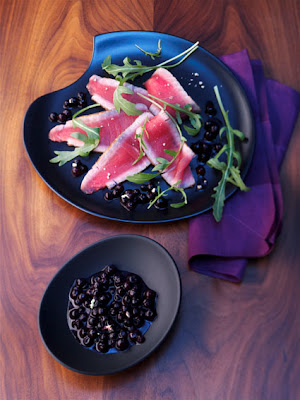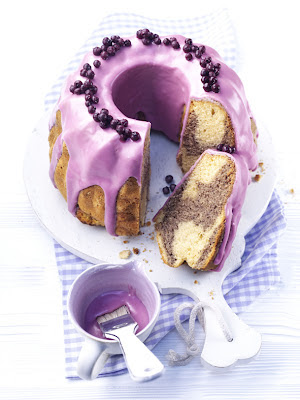Wild Blueberries Create New Traditions in Seasonal Fare
Right now, wild blueberry barrens throughout Maine and Nova Scotia are being fertilized and closely checked for growth and pests as farmers anticipate the coming harvest season. Around here, it seems like everyone has wild blueberries on their mind. Of course, there’s no reason to wait for August when today’s quick freezing technology makes blues straight from the field available anytime, but the thought of thousands of acres of this Maine fruit simultaneously bursting with deep blue color just seems to trigger our taste for the sweet, tangy wild blueberry.

There’s no forcing wild blueberry pie off the most-loved foods list, but there are some other less traditional ways to encounter the area’s indigenous ingredient that have burgeoned in popularity. Recently, the Portland Press Herald discussed the penchant for some to indulge in non-traditional lobster rolls (consider the convention-busting wasabi roll, or the BLT-style roll), and we’re doing the same with wild blueberries. We consider these outside-the-box specialties the new summer essentials. Incorporating them into your summer fare will steer you clear from the hum-drum and satisfy your hankering for the uniquely sweet taste you long for. There are plenty of options perfect for a season ripe for something small, cool and blue!
Blueberries & Seafood: A Sizzling Summer Pairing
Pairing wild blueberries with seafood has been a culinary secret held by the best chefs in the nation. Now it’s yours: blueberries create an ideal flavor profile for all types of proteins, but especially seafood, which comes to life when complemented by a bright, tangy sauce. Wild blueberries fit the bill perfectly due to their particularly complex flavor that’s like no other fruit or berry, and the result can be exquisite.
 For example, wild blueberries paired with hearty fish, like this Grilled Halibut with Blueberry-Pepper Sauce from Heart Healthy Living is the perfect foray into seasonal eating. Think lobster and blueberries make an unlikely pair? Catherine Ryan Quint’s Baked Stuffed Lobster (reprinted here by Maine Travel Maven Hilary Nagle) says differently. Her recipe has a history of taking home the gold at the Machias Wild Blueberry Festival – can hundreds of Down Easters be wrong? The crabmeat and blueberry stuffing is the surprise. Another summer favorite from Food.com gets a new lease on life with Lobster and Crab Cakes with Wild Blueberries. Wild takes these cakes from same-old to seconds-please.
For example, wild blueberries paired with hearty fish, like this Grilled Halibut with Blueberry-Pepper Sauce from Heart Healthy Living is the perfect foray into seasonal eating. Think lobster and blueberries make an unlikely pair? Catherine Ryan Quint’s Baked Stuffed Lobster (reprinted here by Maine Travel Maven Hilary Nagle) says differently. Her recipe has a history of taking home the gold at the Machias Wild Blueberry Festival – can hundreds of Down Easters be wrong? The crabmeat and blueberry stuffing is the surprise. Another summer favorite from Food.com gets a new lease on life with Lobster and Crab Cakes with Wild Blueberries. Wild takes these cakes from same-old to seconds-please.
Blueberry Brews – A Summer Basic with a Twist
Hanging out around festivals tents, backyard barbeques, or under umbrellas on the deck of a local brewery this summer? Then you know that beer is a summer standard. Clearly, local breweries know the flavor for the season: it’s blueberry, and using Maine wild blueberries is imperative for a perfect brew. Atlantic Brewing has the idea with their Bar Harbor Blueberry Ale (their all-ages Blueberry soda is made with Maine blueberries, too). Sebago Brewing, not to be outdone, offers Bass Ackwards Berryblue Ale, brewed exclusively during the Maine blueberry harvest. (They suggest a Black and Blue – Bass Ackwards mixed with Lake Trout Stout – for a killer quaff.) Sea Dog Brewing Company makes their mark as well with Bluepaw Blueberry Wheat Ale, a sud beloved for its fruity, nutty flavor. Try all three and more with Bacon Wrapped Blueberry Jalapeño Poppers, a bar-side favorite with a twist that hails – who knew? – from the South.

Popsicles: Cool Blue Beats the Heat
The best summer treats are cool and blue, and what’s more, they come on a stick! Homemade popsicles with real fruit is ingenious – they cool you down during the heat wave and take advantage of what wild blueberries have to offer in addition to powerful health-preserving antioxidants: big fruit taste. If you don’t have these fruit-forward missiles in your freezer from June to August, then pack up your big-brimmed hat, summer just isn’t for you.
Start with Martha Stewart’s Banana Swirl Popsicles, or these classically cool Blueberry Pops (use frozen just as easily without sacrificing nutrition, taste or convenience). Or, put some Blueberry Pomegranate Pops in your freezer. They are colorful, cute, and cold, and they require just three ingredients and one minute (give or take) to make.
Salsa: The Ultimate Summer Side, Improved (with Blue)
 Why is salsa so summer friendly? It’s a chilly side that incorporates some heat (if you like), and it transcends super snack status by also being a super entrée side. Why wild blues? They represent the epitome of fruit flavor – more so than their cultivated cousins, according to Chef Steve Corry of Portland’s 555 – which turns this classic into something exciting. Dip tortillas in it, pair it with chicken, pork or fish dishes, or heap in on a turkey sandwich for the ultimate solution to the bland dish that incorporates the crucial but sometimes overlooked part of the dietary color spectrum. Here’s an elegant recipe for Blueberry Salsa from Whole Living – the Kitchen Is My Playground takes you through the all the visual steps. It uses the typical ingredients, including cilantro, jalapeno and lime juice, and takes it all to the extreme with the smashing taste of blueberries. Or, dip into Mango Blueberry Salsa. Its big taste is courtesy of an expert Maine chef, Executive Chef Louis Kiefer Jr. of the Bar Harbor Inn. You can also use your own garden bounty (or someone else’s) to make this Blueberry and Basil Habanero Salsa from Closet Cooking, a savory salsa that provides fresh taste with some heat.
Why is salsa so summer friendly? It’s a chilly side that incorporates some heat (if you like), and it transcends super snack status by also being a super entrée side. Why wild blues? They represent the epitome of fruit flavor – more so than their cultivated cousins, according to Chef Steve Corry of Portland’s 555 – which turns this classic into something exciting. Dip tortillas in it, pair it with chicken, pork or fish dishes, or heap in on a turkey sandwich for the ultimate solution to the bland dish that incorporates the crucial but sometimes overlooked part of the dietary color spectrum. Here’s an elegant recipe for Blueberry Salsa from Whole Living – the Kitchen Is My Playground takes you through the all the visual steps. It uses the typical ingredients, including cilantro, jalapeno and lime juice, and takes it all to the extreme with the smashing taste of blueberries. Or, dip into Mango Blueberry Salsa. Its big taste is courtesy of an expert Maine chef, Executive Chef Louis Kiefer Jr. of the Bar Harbor Inn. You can also use your own garden bounty (or someone else’s) to make this Blueberry and Basil Habanero Salsa from Closet Cooking, a savory salsa that provides fresh taste with some heat.
Got a summer recipe that uses wild blueberries? Whether it’s a classic dish or an extreme creation, tell us.




